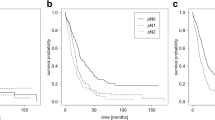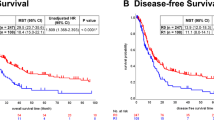Abstract
Background and objectives
The aim of this study was to assess the overall survival (OS) after R0/R1 resections in patients with pancreatic ductal adenocarcinoma (PDAC) of the pancreatic head after implementation of a standardized histopathologic protocol (Leeds Pathology Protocol, LEEPP).
Methods
One hundred and twenty-five patients underwent surgical resection because of PDAC of the pancreatic head. Patients were histopathologically examined according to a standardized protocol. Their oncologic outcome and clinicopathologic data were compared with those of a patient group before implementation of the LEEPP (n = 116).
Results
The R1 rate increased significantly from 13 to 52 %. There was no significant difference in OS between R0 and R1 resections. The median OS in patients with a tumor clearance of less than 2 mm from the resection margin was 15.1 months (12.1–18.1 months) versus 22.2 months (7.8–36.7 months) (P = 0.046). Multivariate analysis revealed a margin clearance or 2 mm and more as an independent prognosticator for OS.
Conclusions
With applying the LEEPP, there was still no significant correlation between the R-status and OS in patients with PDAC. However, since a margin clearance of 2 mm or more is a predictive factor for OS, the R1 definition might have to be adapted in PDAC.

Similar content being viewed by others
References
Birbeck KF, Macklin CP, Tiffin NJ et al (2002) Rates of circumferential resection margin involvement vary between surgeons and predict outcomes in rectal cancer surgery. Ann Surg 235:449–457
Wibe A, Rendedal PR, Svensson E et al (2002) Prognostic significance of the circumferential resection margin following total mesorectal excision for rectal cancer. Br J Surg 89:327–334
Agrawal S, Belghiti J (2011) Oncologic resection for malignant tumors of the liver. Ann Surg 253:656–665
Dexter SP, Sue-Ling H, McMahon MJ et al (2001) Circumferential resection margin involvement: an independent predictor of survival following surgery for oesophageal cancer. Gut 48:667–670
Neoptolemos JP, Stocken DD, Dunn JA et al (2001) Influence of resection margins on survival for patients with pancreatic cancer treated by adjuvant chemoradiation and/or chemotherapy in the ESPAC-1 randomized controlled trial. Ann Surg 234:758–768
Neoptolemos JP, Stocken DD, Friess H et al (2004) A randomized trial of chemoradiotherapy and chemotherapy after resection of pancreatic cancer. N Engl J Med 350:1200–1210
Verbeke CS, Leitch D, Menon KV et al (2006) Redefining the R1 resection in pancreatic cancer. Br J Surg 93:1232–1237
Menon KV, Gomez D, Smith AM et al (2009) Impact of margin status on survival following pancreatoduodenectomy for cancer: the Leeds Pathology Protocol (LEEPP). HPB (Oxford) 11:18–24
Verbeke CS (2008) Resection margins and R1 rates in pancreatic cancer—are we there yet? Histopathology 52:787–796
Verbeke CS, Gladhaug IP (2012) Resection margin involvement and tumour origin in pancreatic head cancer. Br J Surg 99(1036–104):9
Esposito I, Kleeff J, Bergmann F et al (2008) Most pancreatic cancer resections are R1 resections. Ann Surg Oncol 15:1651–1660
Janot MS, Kersting S, Belyaev O et al (2012) Can the new RCP R0/R1 classification predict the clinical outcome in ductal adenocarcinoma of the pancreatic head? Langenbecks Arch Surg 397:917–925
Hartwig W, Hackert T, Hinz U et al (2011) Pancreatic cancer surgery in the new millennium: better prediction of outcome. Ann Surg 254:311–319
Gebauer F, Kloth K, Tachezy M et al (2012) Options and limitations in applying the fistula classification by the International Study Group for pancreatic fistula. Ann Surg 256:130–138
Uzunoglu FG, Stehr A, Fink JA et al (2012) Ultrasonic dissection versus conventional dissection techniques in pancreatic surgery: a randomized multicentre study. Ann Surg 256:675–680
Yekebas EF, Wolfram L, Cataldegirmen G et al (2007) Postpancreatectomy hemorrhage: diagnosis and treatment: an analysis in 1669 consecutive pancreatic resections. Ann Surg 246:269–280
Yeo CJ (2000) The Johns Hopkins experience with pancreaticoduodenectomy with or without extended retroperitoneal lymphadenectomy for periampullary adenocarcinoma. J Gastrointest Surg 4:231–232
Pedrazzoli S, Pasquali C, Sperti C (2005) Extent of lymphadenectomy in the resection of pancreatic cancer. Analysis of the existing evidence. Rocz Akad Med Bialymst 50:85–90
Farnell MB, Pearson RK, Sarr MG et al (2005) A prospective randomized trial comparing standard pancreatoduodenectomy with pancreatoduodenectomy with extended lymphadenectomy in resectable pancreatic head adenocarcinoma. Surgery 138:618–628 (discussion 628–630)
Campbell F, Foulis AK, Verbeke CS (2010) Standards and datasets for reporting cancers. Dataset for the histopathological reporting of carcinomas of the pancreas, ampulla of Vater and common bile duct. The Royal College of Pathologists, UK. http://www.rcpath.org/Resources/RCPath/Migrated%20Resources/Documents/D/datasethistopathologicalreportingcarcinomasmay10.pdf
Neoptolemos JP, Stocken DD, Bassi C et al (2010) Adjuvant chemotherapy with fluorouracil plus folinic acid vs gemcitabine following pancreatic cancer resection: a randomized controlled trial. JAMA 304:1073–1081
Oettle H, Post S, Neuhaus P et al (2007) Adjuvant chemotherapy with gemcitabine vs observation in patients undergoing curative-intent resection of pancreatic cancer: a randomized controlled trial. JAMA 297:267–277
Rau BM, Moritz K, Schuschan S et al (2012) R1 resection in pancreatic cancer has significant impact on long-term outcome in standardized pathology modified for routine use. Surgery 152:S103–S111
Westgaard A, Tafjord S, Farstad IN et al (2008) Resectable adenocarcinomas in the pancreatic head: the retroperitoneal resection margin is an independent prognostic factor. BMC Cancer 8:5
Gnerlich JL, Luka SR, Deshpande AD et al (2012) Microscopic margins and patterns of treatment failure in resected pancreatic adenocarcinoma. Arch Surg 147:753–760
Verbeke CS, Menon KV (2008) Variability in reporting resection margin status in pancreatic cancer. Ann Surg 247:716–717
Yeo CJ, Cameron JL, Lillemoe KD et al (1995) Pancreaticoduodenectomy for cancer of the head of the pancreas. 201 patients. Ann Surg 221:721–731 (discussion 731–723)
Khalifa MA (2007) Intraoperative assessment of the Whipple resection specimen. J Clin Pathol 60:975–980
Chang DK, Johns AL, Merrett ND et al (2009) Margin clearance and outcome in resected pancreatic cancer. J Clin Oncol 27:2855–2862
Karamitopoulou E, Zlobec I, Born D et al (2013) Tumour budding is a strong and independent prognostic factor in pancreatic cancer. Eur J Cancer 49(5):1032–1039. doi:10.1016/j.ejca.2012.10.022
Zhang Y, Frampton AE, Cohen P et al (2012) Tumor infiltration in the medial resection margin predicts survival after pancreaticoduodenectomy for pancreatic ductal adenocarcinoma. J Gastrointest Surg 16:1875–1882
Yekebas EF, Bogoevski D, Cataldegirmen G et al (2008) En bloc vascular resection for locally advanced pancreatic malignancies infiltrating major blood vessels: perioperative outcome and long-term survival in 136 patients. Ann Surg 247:300–309
Bockhorn M, Burdelski C, Bogoevski D et al (2010) Arterial en bloc resection for pancreatic carcinoma. Br J Surg 98:86–92
Conflict of interest
All contributing authors declare no conflict of interest.
Author information
Authors and Affiliations
Corresponding author
Additional information
Florian Gebauer and Michael Tachezy contributed equally to this work.
Rights and permissions
About this article
Cite this article
Gebauer, F., Tachezy, M., Vashist, Y.K. et al. Resection Margin Clearance in Pancreatic Cancer After Implementation of the Leeds Pathology Protocol (LEEPP): Clinically Relevant or Just Academic?. World J Surg 39, 493–499 (2015). https://doi.org/10.1007/s00268-014-2808-4
Published:
Issue Date:
DOI: https://doi.org/10.1007/s00268-014-2808-4




